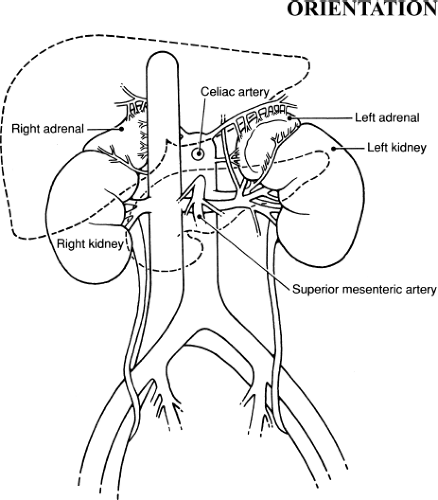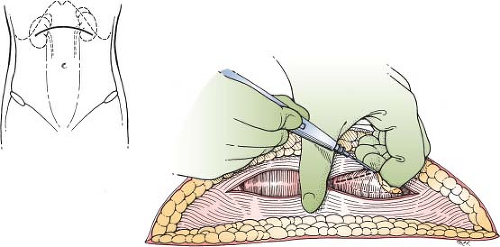Adrenalectomy
The optimal choice of surgical approach in adrenal surgery depends on many factors including the dimensions of the mass, its location and size, functional status, the patient’s preoperative condition, and the surgeon’s experience. Laparoscopic adrenalectomy has become the “gold standard” for treatment of benign adrenal tumors over the last 2 decades. Current indications for open adrenalectomy are limited to large tumors (>6 to 10 cm), malignant or possibly malignant tumors, or conditions hostile to a laparoscopic approach. In this chapter, the open transabdominal approach to the adrenal glands is described because it is appropriate for bilateral tumors, such as pheochromocytomas, allows for complete examination of the abdominal cavity, as well as resection of extra-adrenal lesions.
The posterior approach to the adrenals is rarely performed. In the past, it was performed for endocrine ablation or for resection of a small, isolated aldosteronoma. It is described at the end of this chapter because it is still occasionally used when the anterior laparoscopic or open approaches are contraindicated. It also provides the anatomic basis for posterior minimally invasive approaches to the glands.
A lateral or flank approach provides excellent exposure, especially for the right adrenal gland. However, it is rarely used except in conversion from the laparoscopic approach. References at the end of this chapter provide details of exposure using this method. Occasionally, large adrenal tumors require a thoracoabdominal incision for adequate exposure. Again, this is rare.
Laparoscopic adrenalectomy is described in Chapter 106.
SCORE™, the Surgical Council on Resident Education, classified open adrenalectomy as a “COMPLEX” procedure.
STEPS IN PROCEDURE
Transabdominal Adrenalectomy
Supine position, roll under lower costal margin
Bilateral subcostal or midline incision
Thorough abdominal exploration
Left Adrenalectomy
Divide gastrocolic omentum and retract stomach cephalad
Incise peritoneum along inferior border of pancreas and gently retract cephalad
Reflect transverse colon inferiorly
Palpate kidney and incise Gerota fascia just medial to superior aspect of kidney
Identify adrenal gland and left renal vein
Expose anterior surface of left renal vein
Identify left adrenal vein; divide now or later
Identify and divide small branches from inferior phrenic artery and vein
Divide adrenal vein if not already taken
Right Adrenalectomy
Reflect hepatic flexure downward and fully mobilize duodenum
Retract liver cephalad
Palpate right kidney and identify adrenal gland just medial to inferior vena cava at superior pole of kidney
Expose adrenal gland
Identify and secure right adrenal vein
Secure small vessels along medial aspect of gland and remove it
Posterior Adrenalectomy
Patient is positioned prone with slight break to straighten the curvature of the spine
Incision straight from tenth rib downward, then curving laterally toward iliac crest
Divide attachments of erector spinae muscle to twelfth rib and resect rib (subperiosteally)
Expose Gerota fascia and elevate diaphragm and pleura
Pull downward on kidney to expose adrenal gland
Divide attachments of adrenal gland, leaving vein for last step (both sides)
Ligate adrenal vein and divide it
Obtain hemostasis and close without drains
HALLMARK ANATOMIC COMPLICATIONS
Injury to inferior vena cava (right)
Entry into pleural space (posterior adrenalectomy)
LIST OF STRUCTURES
Adrenal (Suprarenal) Glands
Left and right suprarenal veins
Inferior phrenic vein
Inferior phrenic artery
Superior suprarenal arteries
Middle suprarenal artery
Inferior suprarenal artery
Kidneys
Left renal vein
Left gonadal vein
Gerota fascia
Inferior vena cava
Organ of Zuckerkandl
Trapezius muscle
Latissimus dorsi muscle
Erector spinae muscles
Internal oblique muscle
Transversus abdominis muscle
Quadratus lumborum muscle
Lumbodorsal fascia
Eleventh and twelfth ribs
The right adrenal gland nestles close to the inferior vena cava, and the left adrenal gland is located relatively higher and more lateral, close to the renal vein, but relatively far from the aorta and inferior vena cava (Fig. 105.1). Differences in relative location and nature of blood supply and venous drainage necessitate modifications in technique depending upon which gland is being approached. Here, left adrenalectomy is described first, followed by right adrenalectomy.
Transabdominal Adrenalectomy Incision (Fig. 105.2)
Technical Points
Position the patient supine on the operating table with a roll under the lower costal margin, or break the operating table slightly to elevate the upper abdomen. Plan a bilateral subcostal or midline incision, depending on the physical habitus of the patient. For most patients, a subcostal approach is best. It may be necessary to make this incision quite long to obtain adequate exposure, especially in obese patients. Thoroughly explore the abdomen in the usual fashion.
Anatomic Points
The right adrenal lies slightly lower than the left and is conveniently approached through a right subcostal incision. Access to the left adrenal is more difficult because the gland occupies a more cephalad position. Although both adrenal glands are covered by overlying structures of the gastrointestinal tract, mobilization of these structures is easier on the right than on the left.
Left Adrenalectomy (Fig. 105.3)
Technical Points
Divide the gastrocolic omentum widely by taking the omentum off the greater curvature of the stomach. Serially control and divide the multiple branches of the gastroepiploic artery and vein that extend from the omentum to the greater curvature. Elevate the stomach cephalad with a retractor. Incise the peritoneum lying along the inferior border of the pancreas and gently elevate the pancreas by blunt dissection. Place a Harrington retractor on a moist laparotomy pad to elevate the pancreas. Reflect the transverse colon downward to improve exposure (Fig. 105.3A). Rarely, it may be necessary to mobilize the splenic flexure to achieve adequate exposure. Generally, the adrenal gland lies far enough medially that simple downward traction on the colon suffices.
Exposure obtained through the lesser sac is limited and is appropriate only for small or superiorly located tumors. If wider exposure is required, fully mobilize the spleen and tail of the pancreas up into the midline to expose the underlying retroperitoneal structures.
Palpate the kidney and use this as a guide to the left adrenal, which lies just cephalad and medial. Incise Gerota fascia just medial to the superior aspect of the left kidney. The adrenal gland should be palpable and visible in this region. Identify the left renal vein and open the tissues overlying it to expose its anterior surface. The left gonadal vein is a useful landmark. The left adrenal vein generally lies just medial to it, on the superior aspect of the left renal vein. Begin to mobilize the adrenal gland by clipping small branches from the inferior phrenic artery and vein, which may enter the superior and medial borders of the adrenal. Secure these with hemoclips and divide them. The harmonic scalpel facilitates divison of these branches, which are often embedded in retroperitoneal fat. It should then be possible to slip a finger behind the adrenal and elevate it. This posterior plane is generally avascular. Downward mobilization of the adrenal gland is facilitated by keeping the attachments to the kidney intact until the vein is approached.
The adrenal vein passes inferiorly. Trace the superior aspect of the left renal vein to identify the relatively long adrenal vein passing off the superior surface just medial to the entrance of the gonadal vein. Ligate it in continuity and divide it (Fig. 105.3B). Leave the tie on the adrenal side long and use it to further elevate the adrenal into the field. Divide any remaining connections at the superior aspect of the gland hemostatically (Fig. 105.3C). Because these contain only multiple, small arterial twigs, no major structures are at risk for injury.
Stay updated, free articles. Join our Telegram channel

Full access? Get Clinical Tree




